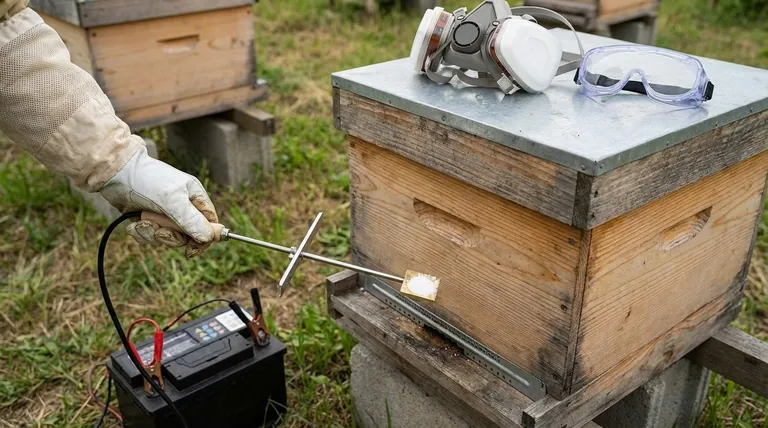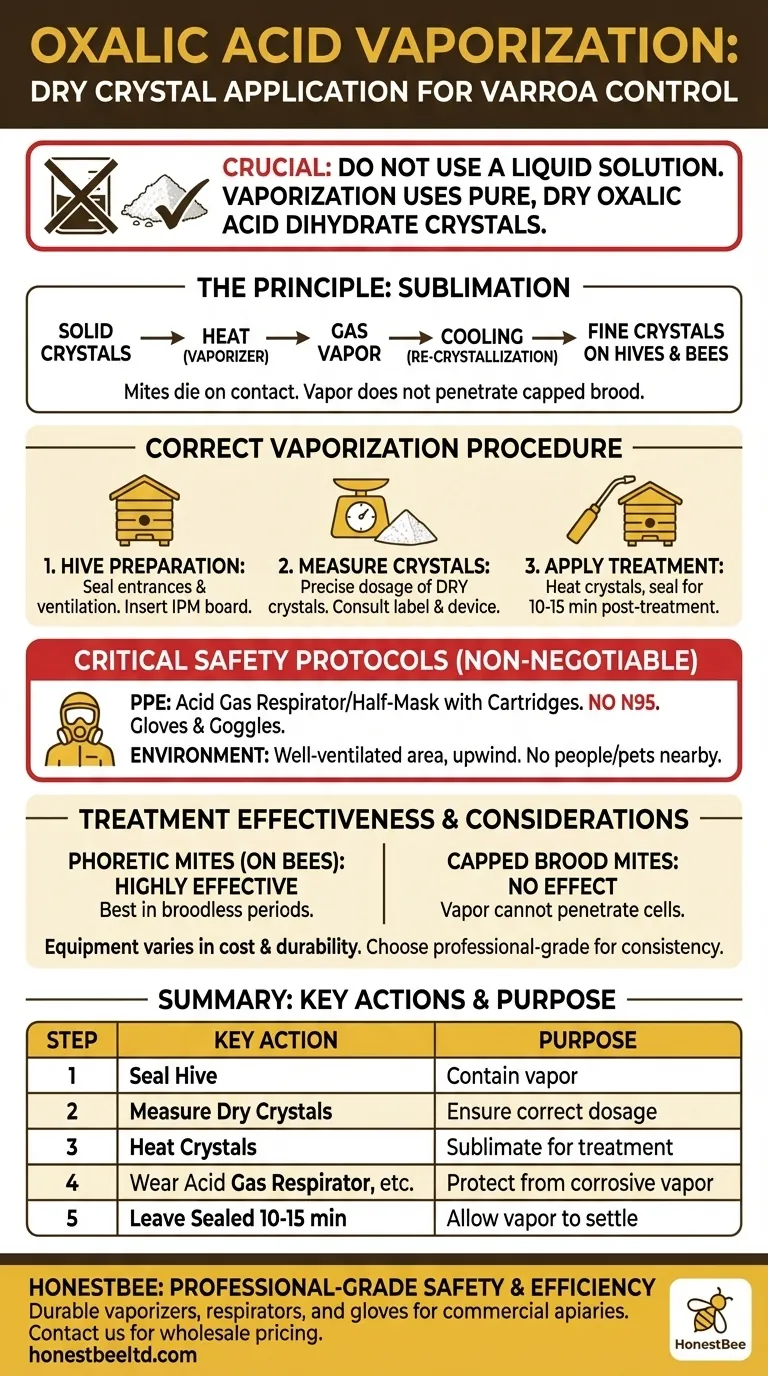Crucially, the oxalic acid vaporization method does not use a liquid solution. This is a common and critical point of confusion. For vaporization, you use pure, dry oxalic acid dihydrate crystals, which are heated to create a vapor that fills the hive. No water or sugar is ever added for this specific treatment method.
The core principle to understand is the difference in application. Oxalic acid vaporization (sublimation) uses dry crystals to create a gas. Oxalic acid dribbling uses a liquid solution mixed with sugar water. These methods are not interchangeable.

The Principle Behind Vaporization
What is Oxalic Acid Vaporization?
Oxalic acid vaporization, also known as sublimation, is a treatment method for Varroa mites in honeybee colonies.
The process involves heating oxalic acid dihydrate crystals in a specialized tool called a vaporizer. This heating turns the solid crystals directly into a gas, which is then dispersed throughout the sealed hive.
How it Affects Mites
As this vapor cools, it re-crystalizes into microscopic, sharp crystals that coat the surfaces inside the hive, including the bees themselves.
When Varroa mites come into contact with these fine crystals, the acid is absorbed, leading to their death. The goal is not to douse the bees, but to permeate the hive environment with the active treatment.
The Correct Vaporization Procedure
Step 1: Hive Preparation
Before beginning, ensure the hive is properly sealed to contain the vapor. Block any upper entrances and ventilation holes.
If you use a screened bottom board, insert the solid slide-in board (IPM board) to prevent the vapor from escaping downwards.
Step 2: Measuring the Crystals
The most important step is to measure the precise dosage of dry oxalic acid dihydrate crystals.
The correct amount depends on the size of your hive and is specified by the product label and your vaporizer's instructions. Do not guess or estimate this amount.
Step 3: Applying the Treatment
Place the measured crystals into the cup or plate of your vaporizer wand.
Insert the wand into the hive entrance, seal the entrance around the wand with a damp cloth or foam, and connect the vaporizer to its power source to begin heating. Once the treatment cycle is complete, leave the hive sealed for an additional 10-15 minutes to allow the vapor to settle.
Critical Safety Protocols
Personal Protective Equipment (PPE)
Oxalic acid vapor is extremely corrosive and damaging to the human respiratory system, eyes, and skin. This is non-negotiable.
You must wear a properly rated acid gas respirator or a half-mask respirator with acid gas cartridges. A simple N95 dust mask is insufficient and offers no protection against the vapor. Chemical-resistant gloves and safety goggles are also mandatory.
Environmental Safety
Always perform the treatment in a well-ventilated area, standing upwind from the hive entrance.
This prevents any leaking vapor from blowing back into your face. Ensure no pets or other people are nearby during the application.
Understanding the Trade-offs
Treatment Effectiveness
Oxalic acid vaporization is highly effective at killing phoretic mites—the mites riding on adult bees.
However, the vapor does not penetrate capped brood cells. This means it will not kill mites that are reproducing within those cells. For this reason, it is most effective during broodless periods, such as in late fall or early winter.
Equipment Considerations
Vaporizers vary widely in cost and durability. Less expensive wands may work well but may not last as many seasons.
More durable, professional-grade models are an investment but offer consistency and longevity. When choosing, consider how many hives you manage and how frequently you will be treating.
Making the Right Choice for Your Goal
- If your primary focus is treating a broodless colony: Vaporization is an excellent and highly effective choice for reducing phoretic mite populations with minimal intrusion.
- If you must treat a colony with significant brood: Understand that vaporization will not be a complete solution and may require repeat applications or integration with another treatment that can target mites in capped cells.
- If your priority is absolute safety: Never compromise on PPE. Invest in a proper acid gas respirator and follow all manufacturer instructions for your equipment to the letter.
Properly applied, oxalic acid vaporization is a powerful tool for maintaining the health of your colonies.
Summary Table:
| Step | Key Action | Purpose |
|---|---|---|
| 1 | Seal the hive completely | Contain the vapor for maximum effectiveness |
| 2 | Measure dry oxalic acid dihydrate crystals precisely | Ensure correct dosage for hive size and safety |
| 3 | Use a vaporizer to heat crystals into gas | Sublimate crystals to treat phoretic mites |
| 4 | Wear acid gas respirator, gloves, and goggles | Protect against corrosive vapor |
| 5 | Leave hive sealed for 10-15 minutes post-treatment | Allow vapor to settle and re-crystallize |
Equip Your Apiary with Professional-Grade Safety and Efficiency
For commercial apiaries and beekeeping equipment distributors, precise and safe Varroa mite control is non-negotiable. HONESTBEE supplies durable, professional-grade oxalic acid vaporizers and essential safety gear—like acid gas respirators and chemical-resistant gloves—to ensure your treatments are effective and protect your team.
Contact us today to discuss wholesale pricing on reliable vaporization equipment tailored for large-scale operations. Let’s keep your colonies healthy and your beekeeping business thriving.
Visual Guide

Related Products
- Oxalic Acid Vaporizer 12V for Bee Varroa Mite Treatment
- Varroa Easy Check Mite Tester Kit Counter Alcohol Wash Jar
- Professional Galvanized Hive Strap with Secure Locking Buckle for Beekeeping
- Full Set Beekeeping Electronic Bee Venom Collector Machine Device for Bee Venom Collecting
- HONESTBEE 6 Frame Three Use Electric Honey Extractor for Beekeeping
People Also Ask
- What should be inserted under the hive to reduce drafts during oxalic acid vaporization? Ensure Effective Varroa Mite Control
- What is the role of oxalic acid in plants? A Key to Plant Defense and Internal Regulation
- What is the most common method of applying oxalic acid for mite control? Dribble vs. Vaporization for Varroa
- What are the methods for applying oxalic acid in beekeeping? Control Varroa Mites Effectively
- What are the registered application methods for oxalic acid in beekeeping? Choose the Right Varroa Mite Treatment



















